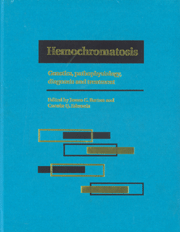Book contents
- Frontmatter
- Contents
- List of contributors
- Foreword
- Part I Introduction to hemochromatosis
- Part II Genetics of hemochromatosis
- Part III Metal absorption and metabolism in hemochromatosis
- Part IV Diagnostic techniques for iron overload
- Part V Complications of iron overload
- Part VI Therapy of hemochromatosis and iron overload
- Part VII Infections and immunity in hemochromatosis
- 35 Role of iron in infections and immunity
- 36 Bacterial infections in hemochromatosis
- 37 Chronic viral hepatitis and hemochromatosis
- 38 T-lymphocyte expression and function in hemochromatosis
- Part VIII Hemochromatosis heterozygotes
- Part IX Relationship of hemochromatosis to other disorders
- Part X Animal models of hemochromatosis and iron overload
- Part XI Screening for hemochromatosis
- Part XII Hemochromatosis: societal and ethical issues
- Part XIII Final issues
- Index
35 - Role of iron in infections and immunity
from Part VII - Infections and immunity in hemochromatosis
Published online by Cambridge University Press: 05 August 2011
- Frontmatter
- Contents
- List of contributors
- Foreword
- Part I Introduction to hemochromatosis
- Part II Genetics of hemochromatosis
- Part III Metal absorption and metabolism in hemochromatosis
- Part IV Diagnostic techniques for iron overload
- Part V Complications of iron overload
- Part VI Therapy of hemochromatosis and iron overload
- Part VII Infections and immunity in hemochromatosis
- 35 Role of iron in infections and immunity
- 36 Bacterial infections in hemochromatosis
- 37 Chronic viral hepatitis and hemochromatosis
- 38 T-lymphocyte expression and function in hemochromatosis
- Part VIII Hemochromatosis heterozygotes
- Part IX Relationship of hemochromatosis to other disorders
- Part X Animal models of hemochromatosis and iron overload
- Part XI Screening for hemochromatosis
- Part XII Hemochromatosis: societal and ethical issues
- Part XIII Final issues
- Index
Summary
Introduction
Maintenance of immune function and defenses against infection requires careful physiological control of various metabolic events. The homeostatic regulation of iron metabolism exemplifies this requirement. The body is faced with the fundamental problem of ensuring that mechanisms exist to allow acquisition of iron by host tissues, while at the same time preventing its becoming readily available to invading microorganisms. For this to occur, two conditions have to be met:
(i) Specific mechanisms must exist to allow iron to be available for a regulated uptake and utilization by host tissues, but at the same time:
(ii) Iron must not be present in forms that are readily utilized by microorganisms, or could cause potentially toxic reactions.
In hemochromatosis, the regulation implied by the former condition is disrupted, with a consequent danger that the latter condition will also not be met. This chapter reviews the role played by iron in normal immune function, the potential for iron overload to cause dysregulation of the immune system, and the extent to which this is realized in hemochromatosis. More specific topics, such as the role of iron in microbial pathogenicity, its effect on viral hepatitis, and abnormalities in lymphocyte subsets are addressed in other chapters.
The immune system
The immune system consists of a complex network of leukocytes (lymphocytes, macrophages/monocytes, neutrophils, dendritic cells, etc.) and soluble mediators (immunoglobulins, cytokines) the activities of which are tightly controlled and extensively interlinked. Although some functional redundancy may occur (e. g., among cytokines), most individual components have crucial functions that, if unable to operate normally, may lead to immunological defects.
- Type
- Chapter
- Information
- HemochromatosisGenetics, Pathophysiology, Diagnosis and Treatment, pp. 371 - 380Publisher: Cambridge University PressPrint publication year: 2000
- 2
- Cited by



